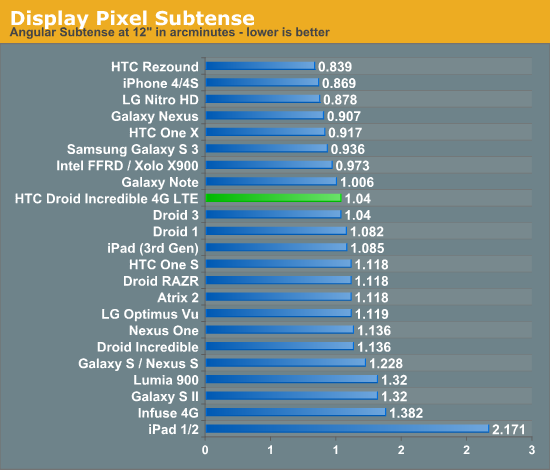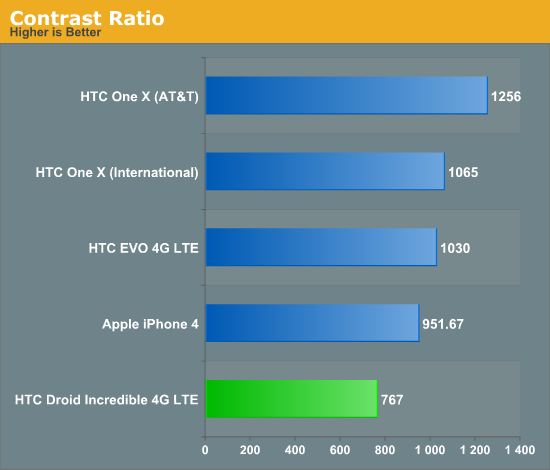HTC Droid Incredible 4G LTE Review: One Alternative
by Jason Inofuentes on July 13, 2012 9:24 PM EST- Posted in
- Smartphones
- HTC
- Droid
- Mobile
This is a good time to be a display lover, both in the mobile space and in the notebook and tablet space. Not that long ago we bemoaned the absurdity of 4.7” WVGA PenTile displays, with pixels so large you could almost imagine them plucking them up with tweezers. Now, we are awash in gorgeous HD displays, PenTile or otherwise, with fantastic viewing angles, fantastic brightness, and somehow adding nothing at all to the thickness of the handset. So, given its family’s ‘halo’ origins, is it a burden for the Incredible 4G to sport a relatively paltry 960x540 qHD display?
The Incredible 4G LTE’s Super LCD 4” panel is not nearly so bad as the resolution might seem to imply. There’s an error endemic to the industry to use size and resolution as the only hallmarks for display quality, and the price for that are absurdities like the HTC Titan’s 4.7” WVGA display. When Apple introduced the Retina Display on the iPhone 4, it was the highest density display seen in the mobile space. That high pixel density was tied to good color representation and excellent viewing angles, and made the iPhone the gold standard for phone displays. The first return salvo from Android manufacturer’s were bigger. That trend started with the Droid X, which at 4.3” was considered possitively massive at the time; though its WVGA resolution made it adequate at best in terms of pixel density. Over the next year and a half displays continued to grow (capping out at the Note’s 5.3” display), while resolutions stalled first at WVGA, then briefly at qHD and now finally at 720p. PenTile was a temporizing move, that had mixed results at first, and was glaring at lower resolutions. We hope that issue has finally been settled with screens like the Galaxy S III’s 4.8” HD Super AMOLED panel showing that subpixel densities well above 300 ppi make the stripe indistinguishable to the human eye.
But in real terms, if there are to be smaller screens, there must be lower resolutions. Let's take for example a theoretical 4" 1280x720 panel; with a pixel density of 367 ppi it would be the highest density display on a phone by some margin. There's a real power cost to pushing those extra pixels, both in terms of the panel and the additional GPU performance necessary. Now, HTC could overcome the power issue without resorting to an ever thicker body, or one more oddly shaped, I would be first in line for that device. Until then, though, a 4" phone deserves a greater than WVGA resolution, and qHD is the right choice.

Angular resolution is our latest display measurement, and with it the key to recall is that as you approach and then drop below 1 arc minute, the human eye's ability to discern an individual pixel becomes impossible. The Incredible 4G's panel fares better here than other qHD screens, and is almost but not quite at 1 arc minute. This matches real world performance, where unless I brought the screen artificially close to my eyes, I never noticed individual pixels. Does the One X have a better angular resolution? Yep. Would a 720p 4" panel have a better angular resolution? Yep. Does that make this a bad display? Not at all.



Brightness is comparable to the rest of the One series, though black level isn’t exactly stellar. The result is a contrast ratio which isn’t class leading, but certainly not unlivable. If you watch a lot of movies on your phone you might have some satisfaction issues; but then you're watching a movie on a 4" display so, since you've already overcome that, you'll hardly notice. Where there are no compromises is in viewing angles or outdoor visibility. RGB coverage looks great, and color temperature is good at just under 7000K. In the last few years, smaller phones have been left to smaller pricing, and often suffered from poorer displays as a result. Here though, there've been no concessions made to quality; if there’s room for a 4” device in the mobile handset space, it should be as good as the Incredible 4G LTE’s.


_575px.jpg)














24 Comments
View All Comments
aNYthing24 - Tuesday, July 24, 2012 - link
The One S has a Super AMOLED display, not a Super LCD.Omega215D - Tuesday, July 24, 2012 - link
Kind of strange how battery life differs from other reviews. So far only a couple have said subpar life while more have gotten good to very good usage time. Could it be a problem with the phone itself? Well, it's nice to know my Rezound isn't too bad but I do like the designs of both the Incredible and Rezound.pikahatonjon - Tuesday, July 24, 2012 - link
what is with the differences with the EVO 4G LTE & the Htc One X (att) in the contrast test.also, is the Tmobile Galaxy S 3 actually brighter than the At&t galaxy s 3. arent the 4 phones listed above pretty much identical to each other( one series & galaxy s series) what is with the huge diference in the brightness/contrast test
Rockmandash12 - Tuesday, July 24, 2012 - link
The One X has a Super LCD 2 display, not a TFT display.JimmiG - Tuesday, July 24, 2012 - link
How many more years until Android phones can match the iPhone 4S in terms of 3G web browsing battery life?The Nexus One got 3.77 hours back in 2010 vs 4.5 hours for the iPhone 3G. Fast forward to 2012, and the iPhone 4S has more than doubled the battery life to 9.85 hours, while most Android devices have just barely caught up with the iPhone 3G.
Clearly Apple uses the same batteries as everyone else, so it must come down to incredibly lazy programming and poor power use optimization on the Android side. Some OEMs have apparently taken it in their own hands to optimize battery usage (Samsung, HTC), but this should really be something provided by the core Android OS. Battery life should be the main focus on for the next version of Android!
zorxd - Tuesday, July 24, 2012 - link
The iPhone has a small display. It consume a lot less. AMOLED displays are also not very efficient for displaying white backgrounds found on many web sites.Android's battery life isn't bad. Just look at the cellular talk time.
lunarx3dfx - Tuesday, July 24, 2012 - link
What zorx said. You can't compare the iPhone and most Android phones Apples to Apples because of design differences. I'd be willing to bet money that if you had identical devices, the only difference being that one has an A5 and one has an S4, the S4 would wipe the floor with the A5 in every category except for maybe GPU performance.Not only is the S4 almost certainly more energy efficient due to be being a newer architecture, but it will also smoke it in terms of performance per watt.
A5= Dual Cortex A9's @ 800 MHz
S4= Dual Krait Snapdragons @ 1.5 GHz
On top of clock speed Krait is the ONLY ARM based CPU on the market with out of order execution which is why it is faster than Quad Core CPU's (Exynos 4 and Tegra 3).
Jimmi, I would recommend that you learn a bit about how all of this works before you comment again. The iPhone is a good device (although you couldn't pay me to use one), but in terms of theoretical performance it was out-dated before it was ever even announced.
Phasenoise - Tuesday, July 24, 2012 - link
He indicated, as the article states, that the iphone has superior 3g web browsing battery life.So, for him, perhaps picking display or CPU technologies which consume more power is a poor trade off. He doesn't appear to be interested in theoretical performance, just actual real world browsing usage which as we know is generally not Incredibly taxing (pun intended).
lunarx3dfx - Tuesday, July 24, 2012 - link
The reason I brought up performance, was to illustrate my point that Apple doesn't necessarily make a more efficient product as much as they use low power components. I'll admit that I did get a little lost in my own argument. Oops.JimmiG - Tuesday, July 24, 2012 - link
We will see when the next iPhone comes out with a much bigger display and higher clock speeds but still better battery life. The same thing can be seen with Windows vs OSX on laptops with similar specs - Apple simply spends more time optimizing the software side of their mobile devices.It's not limited to just AMOLED displays, and secondly, the CPU should not spend a lot of time at the highest clockspeed and voltage when you're browsing, especially with 3G which should be bandwidth limited. Unless of course the system is poorly optimized.
I'm an Android user myself, and battery life is the Achilles heel of the system. At the end of the day, my Optimus 2X is down to ~15% of battery while coworkers' iPhones last for two days without charging. It was the same with the Nexus One before that.
Just like the unresponsive and choppy user interface, it's important to realize when there's a problem that needs to be fixed.